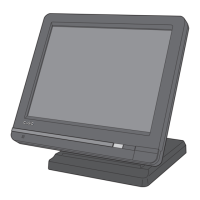
Do you have a question about the Casio QT 6600 - 64 MB RAM and is the answer not in the manual?
| RAM | 64 MB |
|---|---|
| Model | QT-6600 |
| Processor | Unknown |
| Display | Unknown |
| Connectivity | Unknown |
| Operating System | Unknown |
| Dimensions | Unknown |
| Weight | Unknown |
Illustrates the internal and external connections of the QT-6600 system.
Details the standard and hard key code layouts of the terminal keyboard.
Describes the main display, menu level, and keyboard parts of the interface.
Identifies and describes the various input/output ports on the terminal.
Outlines the four available system configurations for the QT-6600.
Provides an overview of the QT-6600 application system and its related settings.
Explains how clerks can be programmed to enable or disable operations in various modes.
Describes how the terminal displays messages to indicate status and required actions.
Details the control system for printing receipts, journals, validations, and reports.
Explains the configuration and processing for remote printer operations.
Describes the shared check tracking system and its cluster configurations.
Details how the terminal can be programmed for clerk interrupt functionality.
Explains the macro command function and scheduled execution capabilities.
Details the function for controlling employee working conditions and attendance.
Explains the function to prohibit sign-on for employees without CLOCK-IN.
Describes the function for capturing registered item data into the IDC file.
Explains the two types of electronic journals: normal and intelligent.
Describes the function for controlling employee working time and clock-out reasons.
Details the terminal's capability for reading magnetic cards.
Explains the three types of initialization: INIT, FC, and INIT2.
Details the process of Initial Program Loading, typically after software modification.
Lists the various functions available under the manager mode for terminal control.
Displays the connection status of terminals and printers within the system.
Command to power on connected terminals via the inline interface.
Command to power off connected terminals via the inline interface.
Releases the busy flag of a check used by another terminal.
Updates PLU, scanning PLU, and department stock quantities.
Displays and prints the terminal's error log file.
Restores system connection table contents to original values, used for recovery.
Allows changing the IDC status to capture or not capture transaction data.
Converts the system to use Euro as the main currency and resets totals.
Enters the software license code for terminal activation.
Performs non-registration operations like data collection and file backup.
Details the X/Z code system for issuing reports and data commands.
Explains X/Z data collection and consolidation processes.
Details inline and online data communication functions.
Explains the maximum inline cable length and connection units.
Provides a description of data collection and consolidation using inline networks.
Explains how to obtain counters and totals of individual terminals.
Details how to obtain the sum of counters and totals from all terminals.
Enables saving and loading terminal program files using various methods.
Explains how to cancel the last registered item using the <VOID> key.
Details how to cancel a previously registered item using the <VOID> key.
Describes how to cancel all registered data using the <CANCEL> key before finalization.
Programs customer data such as name, address, and group information.
Explains the file format for general control settings and parameters.
Explains calculation methods for fixed totalizer memories in registration mode.
Lists error messages, their meanings, and recommended actions for resolution.
Contains a comprehensive list of system error codes and their corresponding meanings.